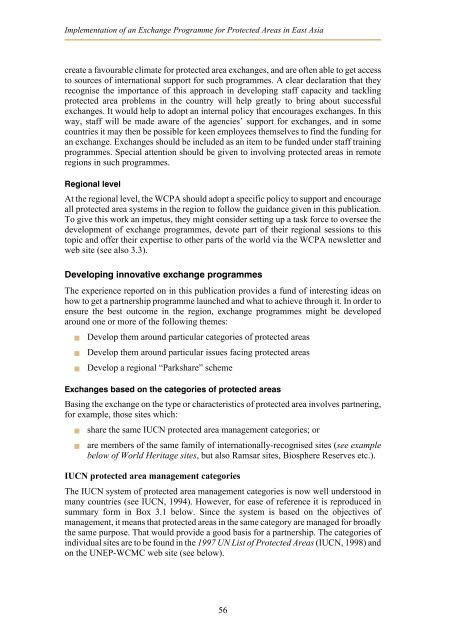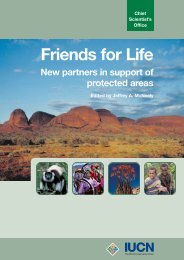Exchange programmes - IUCN
Exchange programmes - IUCN
Exchange programmes - IUCN
You also want an ePaper? Increase the reach of your titles
YUMPU automatically turns print PDFs into web optimized ePapers that Google loves.
Implementation of an <strong>Exchange</strong> Programme for Protected Areas in East Asia<br />
create a favourable climate for protected area exchanges, and are often able to get access<br />
to sources of international support for such <strong>programmes</strong>. A clear declaration that they<br />
recognise the importance of this approach in developing staff capacity and tackling<br />
protected area problems in the country will help greatly to bring about successful<br />
exchanges. It would help to adopt an internal policy that encourages exchanges. In this<br />
way, staff will be made aware of the agencies’ support for exchanges, and in some<br />
countries it may then be possible for keen employees themselves to find the funding for<br />
an exchange. <strong>Exchange</strong>s should be included as an item to be funded under staff training<br />
<strong>programmes</strong>. Special attention should be given to involving protected areas in remote<br />
regions in such <strong>programmes</strong>.<br />
Regional level<br />
At the regional level, the WCPA should adopt a specific policy to support and encourage<br />
all protected area systems in the region to follow the guidance given in this publication.<br />
To give this work an impetus, they might consider setting up a task force to oversee the<br />
development of exchange <strong>programmes</strong>, devote part of their regional sessions to this<br />
topic and offer their expertise to other parts of the world via the WCPA newsletter and<br />
web site (see also 3.3).<br />
Developing innovative exchange <strong>programmes</strong><br />
The experience reported on in this publication provides a fund of interesting ideas on<br />
how to get a partnership programme launched and what to achieve through it. In order to<br />
ensure the best outcome in the region, exchange <strong>programmes</strong> might be developed<br />
around one or more of the following themes:<br />
� Develop them around particular categories of protected areas<br />
� Develop them around particular issues facing protected areas<br />
� Develop a regional “Parkshare” scheme<br />
<strong>Exchange</strong>s based on the categories of protected areas<br />
Basing the exchange on the type or characteristics of protected area involves partnering,<br />
for example, those sites which:<br />
� share the same <strong>IUCN</strong> protected area management categories; or<br />
� are members of the same family of internationally-recognised sites (see example<br />
below of World Heritage sites, but also Ramsar sites, Biosphere Reserves etc.).<br />
<strong>IUCN</strong> protected area management categories<br />
The <strong>IUCN</strong> system of protected area management categories is now well understood in<br />
many countries (see <strong>IUCN</strong>, 1994). However, for ease of reference it is reproduced in<br />
summary form in Box 3.1 below. Since the system is based on the objectives of<br />
management, it means that protected areas in the same category are managed for broadly<br />
the same purpose. That would provide a good basis for a partnership. The categories of<br />
individual sites are to be found in the 1997 UN List of Protected Areas (<strong>IUCN</strong>, 1998) and<br />
on the UNEP-WCMC web site (see below).<br />
56






